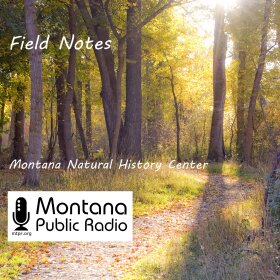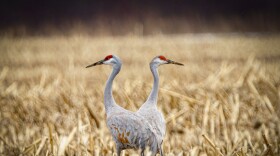
Field Notes
Mon., Wed. Friday at 4:54 p.m.
Nature notes and inquiry from the Montana Natural History Center.
-
This Montana prairie holds a secret. This is coulee country, a landscape peppered with gullies waiting to be explored.
-
A visitor to the Yellowstone National Park helped with a calf struggling to cross a river. After, the calf began approaching people and cars, hazardous for all concerned.
-
Wind has a way of blowing in and cutting short an adventure. It can ruin a picnic. It can wreak havoc on the best-laid plans. At its worst, it can be dangerous and even deadly. But it also creates the breeze that shakes the leaves of quaking aspen. It carries the seeds of black cottonwood and the wings of Red-tailed Hawks to new destinations.
-
Most plants conduct photosynthesis and make their own food from sunlight, carbon dioxide and water. Fungus flowers, however, cannot conduct photosynthesis, making them not only look bizarre but function in a bizarre manner.
-
Tyrell’s tufted, along with most jumping spider species, is not aggressive. Jumping spiders actively hunt their food using their speed, the hunters of the arachnid world.
-
We continue walking, giving the shoreline a wide berth to avoid scaring any loons that might be around. Now we're on the opposite side of the lake and—we see them. Two adult Common Loons. Oh, they're lovely: streamlined, low-slung bodies, perfect for diving. Sleek black heads, red eyes, and characteristic black-and-white coloration that makes it easy to identify them.
-
It’s June and I’m in a dreamy meadow deep in the backcountry of Mount Rainier National Park, looking for toads. My mission: find the toads, count the toads, save the toads—in that order.
-
Crawdads have specialized cells in their exoskeletons that allow them to change color to adapt to their surroundings. The cells, called chromatophores, work to either concentrate or disperse pigment. Similar cells in chameleons and octopuses allow for a quick color change. But, for crawdads, the process is slower.
-
Northern Harriers are considered one of the most elusive raptors, and some of the most accomplished wildlife photographers admit how difficult they are to photograph. Male Harriers, with their white underside and opaque gray-back plumage, seem to be even more challenging to photograph than the brown and much larger females. For that reason, many birders and photographers call male Harriers “Gray Ghosts.”. One moment they’re in your viewfinder, the next, they’re gone.
-
I was delighted to observe such an unusual visitor, but he had a bigger surprise for me. As I watched him forage through my yard he did something unique I had never seen, heard of, nor even imagined!
-
Tufted evening primrose is one of the loveliest native plants found in dry climates across western and central North America. Its botanical name translates to “wine seeker, densely clumped,” which is apt for a low-growing, mounded plant with very fragrant, citrus-scented flowers.
-
I could not articulate what pulled me off the trail, but I followed the urge all the way to the base of the towering tree, a western redcedar. I stood, neck bent back to take in its shading canopy of soft, scaly leaves. We greeted one another in an exchange that predates my ancestors taking human form: the mammalian exhale of carbon dioxide and inhale of oxygen from the trees.
-
Usually, pronghorn will dash away when they see a truck coming. However, at times they race toward me, accelerating, seemingly intent on crossing the road ahead of me.
-
My sister and I struggle to keep up with our mother. Today, we carry gallon-sized Ziploc bags, rolling the nearly-black berries from their stems to our palms to our bags.
-
On this lazy Sunday just outside Missoula, I can hear only two cranes from the former flock. Perhaps these are the late sleepers, the teenagers, left by the wayside as the larger family group launched back to the migratory grind and headed north to their breeding grounds. Spring is the season of courtship, and what I’m listening to may well be the first pairing of lovers who will mate for life.
-
Found in the eastern portion of the United States, deathwatch beetles typically inhabit the hardwood timbers of old buildings or the decaying wood of very old trees. The larvae bore into the wood, feeding for anywhere from one to ten years before pupating and emerging as an adult. And while their wood-boring lifestyle can weaken the structural integrity of some infested buildings, if you believe the superstition, that’s the least of your worries.
-
I’ll never forget the first time I heard the call of a Sandhill Crane. It was early June, and I was halfway through an eight-day backpacking trip in the Sapphire Mountains. Sitting in a meadow one evening and refilling my bottle at the oxbow of a quiet creek, I began to hear a sound unlike anything I’d ever heard. It was part elephant, part jackhammer, and part squeaky door hinge. One thing seemed clear: no way had that sound been made by a modern animal, and certainly not by a bird.
-
I noticed a wide flat tail propelling the shadowy animal forward, and suddenly its head popped up above the water. Two large black eyes considered its surroundings as it meandered upstream. I watched excitedly through my binoculars as it dove smoothly under willow roots and resurfaced near a boulder. After two years of living along this creek, I had finally seen the ever-elusive beaver! I hadn’t really known what beaver signs to look for though as just a novice beaver enthusiast.
-
I love paddling my kayak, to get away even for just an hour or two. Sitting in my kayak one morning on a detention pond close to home, I watched a small, tan spider hopping on my paddle. I quickly took a picture, hoping to identify it later. Before I could enjoy watching this new-to-me spider too much, however, another spider—large, black, and hairy—emerged from under my paddle, ran up to the smaller spider, bit it, and started dragging it off!
-
Then, it happens. A pine squirrel wakes up. First one, then another, then three hundred, then five thousand, and before long the evergreen canopy is buzzing with their banter. From that moment forward, my pre-dawn slyness is a distant memory. There is no unwatched, uncriticized movement in these woods anymore. Any step I take is met with angry feedback from above.
-
We pause our berry gathering to more closely examine the kinnikinnick. On many parts of the shrub, the smooth, leathery green leaf margins are accented by bulbous, yellow-red growths. Unmistakably, these are galls, tumor-like growths of the leaf tissue. Each gall was induced by a manzanita leaf-gall aphid (Tamalia coweni), a female aphid who probes along the leaf to form a tiny home.
-
The cottonwoods and alders on the left and ponderosas and perennial grasses on the right framed the trail as if it were the subject of a painting, drawing our eyes up the valley. Mary was celebrating the variety and vigor of the riparian understory when I saw Iris sidestep a stick ahead of us. Iris leaves no stick unturned, so my curiosity was piqued. As we approached, I could see it was a rubber boa!






















